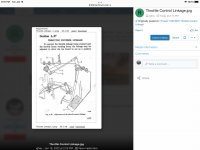Hi Folks,
Have recently purchased a 1964 Austin Healey 3000 BJ8 that has been converted from left to right hand drive. The problem that I am having is that the throttle pedal height appears to be far too high in comparison to the brake and clutch pedal and it is uncomfortable to drive.
Is there a process to rest the height of the pedal? does it involve altering the 'bump stop' and is that a standard part?
Thanks in advice of your input.
Barry.

Have recently purchased a 1964 Austin Healey 3000 BJ8 that has been converted from left to right hand drive. The problem that I am having is that the throttle pedal height appears to be far too high in comparison to the brake and clutch pedal and it is uncomfortable to drive.
Is there a process to rest the height of the pedal? does it involve altering the 'bump stop' and is that a standard part?
Thanks in advice of your input.
Barry.

 Hi Guest!
Hi Guest!

 smilie in place of the real @
smilie in place of the real @
 Pretty Please - add it to our Events forum(s) and add to the calendar! >>
Pretty Please - add it to our Events forum(s) and add to the calendar! >> 



